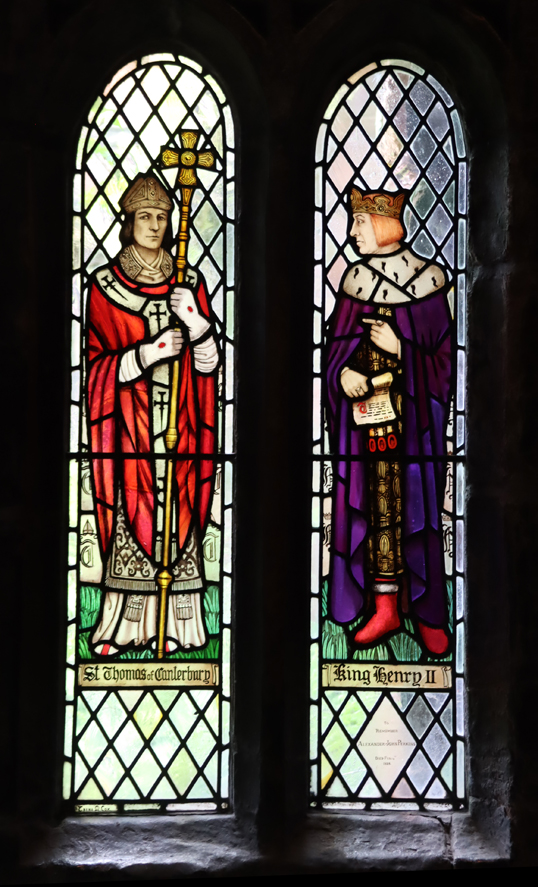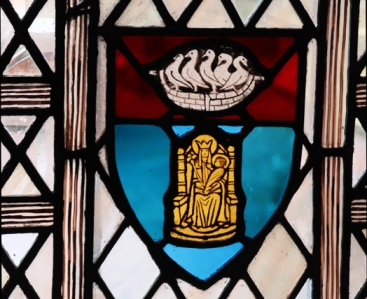 Many thanks to Aleta Doran, Artist in Residence at Chester Cathedral for today’s introduction to stained glass artist Trena Cox, who was based in Chester for most of her long career. Aleta is a brilliant and engaging presenter, currently working hard on the upcoming Trena Cox exhibition, which she is curating. Although this was organized specially for Chester Archaeological Society, Aleta is doing more presentations during the Heritage Festival and if you get the chance to attend, do go. It will give you a completely new insight into the world of 20th Century stained glass, as well as introducing you to a really creative part of the cathedral’s history. I’ll keep this relatively short so as not to spoil the event for those of you who have tickets.
Many thanks to Aleta Doran, Artist in Residence at Chester Cathedral for today’s introduction to stained glass artist Trena Cox, who was based in Chester for most of her long career. Aleta is a brilliant and engaging presenter, currently working hard on the upcoming Trena Cox exhibition, which she is curating. Although this was organized specially for Chester Archaeological Society, Aleta is doing more presentations during the Heritage Festival and if you get the chance to attend, do go. It will give you a completely new insight into the world of 20th Century stained glass, as well as introducing you to a really creative part of the cathedral’s history. I’ll keep this relatively short so as not to spoil the event for those of you who have tickets.
Trena Cox, apparently the least photographed artist in modern history, was born on the Wirral and trained at Birkenhead’s Laird School of art, learning her skills in traditional media before switching to stained glass. She has created over 150 stained glass pieces that are known, but there are probably many more to be identified. She worked mainly in the Cheshire and northeast Wales areas but her works are found further afield. There are many in Chester itself, mainly in churches. There are nine Trena Cox windows in the cathedral, one in the slype (a corridor) and the others arranged in groups of four, two at the top, two at the bottom, in adjacent aisles in the cloister (the walkway around the central garth or garden).
 The big window in the slype shows the child Christ on one river bank, and St Christopher on the other. This is very unconventional, as Christ is usually depicted being carried across the water on the shoulders of St Christopher. Aleta described how this window clearly demonstrates many of the features of Trena Cox’s work, with the beautifully executed details of both figures, the surrounding landscape and the flowers, birds and animals that sit at the feet of the two figures. Also typical are the portrait-style faces, which seem incredibly life-like. The colouring of the glass, as in all her work, is vibrantly jewel-like and the background semi-opaque glass concentrates the eye on colours whilst allowing in light. There are many emblems of international pilgrimage, known from badges purchased from the Middle Ages by pilgrims to commemorate their achievements. As well as many others, these include St Thomas of Canterbury, St James of Santiago de Compostella, and of course Chester Cathedral’s own St Werburgh herself, her symbol being five geese in a basket. It is a rich and symbol-laden piece that rewards time taken to appreciate it.
The big window in the slype shows the child Christ on one river bank, and St Christopher on the other. This is very unconventional, as Christ is usually depicted being carried across the water on the shoulders of St Christopher. Aleta described how this window clearly demonstrates many of the features of Trena Cox’s work, with the beautifully executed details of both figures, the surrounding landscape and the flowers, birds and animals that sit at the feet of the two figures. Also typical are the portrait-style faces, which seem incredibly life-like. The colouring of the glass, as in all her work, is vibrantly jewel-like and the background semi-opaque glass concentrates the eye on colours whilst allowing in light. There are many emblems of international pilgrimage, known from badges purchased from the Middle Ages by pilgrims to commemorate their achievements. As well as many others, these include St Thomas of Canterbury, St James of Santiago de Compostella, and of course Chester Cathedral’s own St Werburgh herself, her symbol being five geese in a basket. It is a rich and symbol-laden piece that rewards time taken to appreciate it.
 The cloister used to open out onto the garth, with a stone arcade forming a corridor with the buildings that surround the cloister. In 1920 Dean Frank Bennet was appointed as the new head of the cathedral, and decided to take measures to improve the cathedral’s fortunes. In order to glaze the arcade that surrounded the garth, the dean decided to raise public funds. It is thought that some funds were raised by allowing donors for the cloister glass to add commemorations to loved ones in panes withing the windows, which survive today. Each window represents a saint, religious festival or holy day. Trena Cox contributed eight panels in two adjacent sections of the cloister, showing eight different saints. In one set of four, the two at the top are Hugh Lupus who founded the abbey and St Werburgh’s mother St Ermengild In the lower section are St Thomas Becket and King Henry II. In the other set, the two figures at the top are Abbot Witchurch and Ralph Higden and the two below King Alfred and St Piegmund. Aleta talked us through the significance of each of these saints, and why there were chosen. These are much smaller and therefore much simpler compositions, but again the colours are vibrant, and the faces resemble portraiture.
The cloister used to open out onto the garth, with a stone arcade forming a corridor with the buildings that surround the cloister. In 1920 Dean Frank Bennet was appointed as the new head of the cathedral, and decided to take measures to improve the cathedral’s fortunes. In order to glaze the arcade that surrounded the garth, the dean decided to raise public funds. It is thought that some funds were raised by allowing donors for the cloister glass to add commemorations to loved ones in panes withing the windows, which survive today. Each window represents a saint, religious festival or holy day. Trena Cox contributed eight panels in two adjacent sections of the cloister, showing eight different saints. In one set of four, the two at the top are Hugh Lupus who founded the abbey and St Werburgh’s mother St Ermengild In the lower section are St Thomas Becket and King Henry II. In the other set, the two figures at the top are Abbot Witchurch and Ralph Higden and the two below King Alfred and St Piegmund. Aleta talked us through the significance of each of these saints, and why there were chosen. These are much smaller and therefore much simpler compositions, but again the colours are vibrant, and the faces resemble portraiture.
Aleta wrapped up by telling us something about Trena Cox and her influence on Chester life, not only as an artist but as something of an activist for the protection of local heritage. It seems remarkable that she is not better known, at least in Chester where she lived nearly all her life. Hopefully, the upcoming the exhibition “Trena Cox: Reflections 100”, which begins on the 7th October, will bring this under-sung local personality and talented, prolific artist to much wider public attention. Do take advantage of a tour of the glass with Aleta Doran if you have the opportunity. As an artist herself, she offers a unique insight into the work of Trena Cox.
You can follow Aleta Doran on Twitter (@StargazingAleta), or via her blog at https://www.aletadoran.co.uk/

